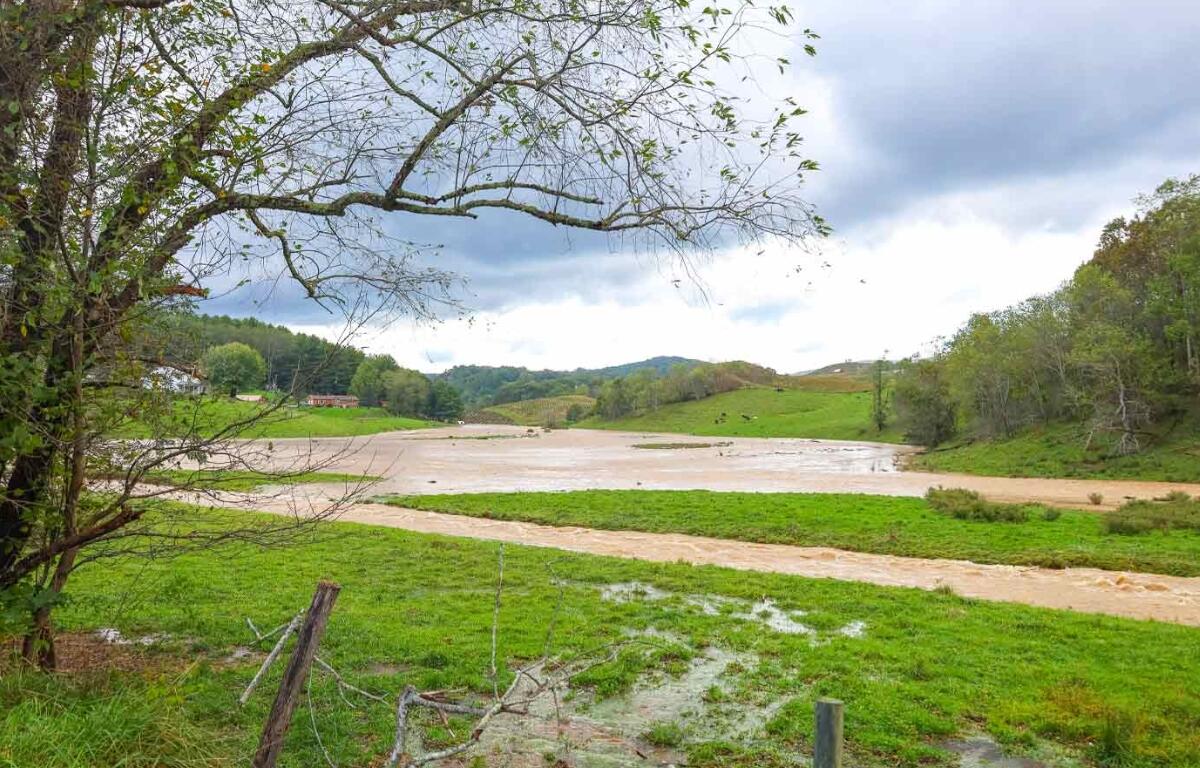ATKINS (Virginia Farm Bureau) — The worst of Hurricane Helene’s unexpected impacts brought out the best in Virginia’s agriculture community. Farmers immediately dispatched hay bales, fencing supplies and financial donations to Southwest Virginia farmers in the aftermath of the September 2024 storm’s catastrophic flood and winds.
Now the U.S. Department of Agriculture is extending more assistance as recovery continues.
Almost $61 million in federal disaster aid funding will cover infrastructure, timber and plasticulture losses in addition to market losses and future economic losses related to Helene.
Jason Pratt, a farmer in Smyth County, lost a barn in the resulting floodwaters and didn’t have flood insurance. Other losses were taken care of by Farm Service Agency programs, but he’s hoping to qualify for additional assistance through the USDA funds.
This funding is part of the $30 billion disaster assistance relief effort authorized by the American Relief Act 2025. U.S. Secretary of Agriculture Brooke Rollins recently signed a block grant agreement with the Virginia Department of Agriculture and Consumer Services that provides recovery assistance for Virginia farmers.
Eligible recipients include impacted commercial agricultural producers and forest landowners. The assistance covers damages to farm infrastructure, timber and aquaculture; market opportunity losses that did not receive insurance payments or federal relief funding; or damage to perennial crops that will result in future income loss.
“From damaged infrastructure to unharvested crops and unrecoverable timber, these impacts are real,” said Virginia Secretary of Agriculture and Forestry Matthew Lohr. “We’re grateful for this federal partnership, which will help ensure Virginia producers can restore operations and remain productive contributors to their communities and the commonwealth.”
Agricultural producers and eligible timber owners in 27 impacted localities can start the process through the Virginia Farm Recovery Block Grant Program portal. Award recipients can expect to receive grant funds later this year.
The localities included in the hurricane’s disaster designation area were determined by the federal government—not VDACS or the state. Disaster recovery applications are available to eligible agricultural and forestry landowners in the counties of Bedford, Bland, Buchanan, Carroll, Craig, Dickenson, Floyd, Giles, Grayson, Lee, Montgomery, Patrick, Pittsylvania, Pulaski, Russell, Scott, Smyth, Tazewell, Washington, Wise and Wythe; and the cities of Bristol, Covington, Danville, Galax, Norton and Radford.
Grayson County Farm Bureau president Danny Boyer lost marketable timber to the storm, which was not initially covered by emergency relief programs. He was unable to salvage the downed timber as he prioritized crucial repairs on 5,000 feet of broken cattle fencing.
“Sawmills cut what salvaged timber they could, but they got so much, they had to stop taking supplies for a while,” Boyer recalled. “But now there is potential to get some assistance for that damaged marketable timber.”
In the region hard-hit by Hurricane Helene, many farmers were reluctant to accept help.
“I’m just blessed I could keep going,” said Boyer, who is still working to repair 2,500 feet of fencing. “Others had their barns and houses washed away.”
Virginia Cooperative Extension agents and Virginia Department of Forestry representatives can assist eligible farmers with registration, deadlines and technical assistance.
Grayson County Extension agent Kevin Spurlin said the block grant package can help farmers with damages not covered by insurance, FSA funds or emergency conservation programs.
They are entitled to assistance, he said.
“This is money set aside for these purposes,” Spurlin explained. “These farmers paid taxes. This is money coming back from what they’ve put in through the years and will help with losses that aren’t covered in other ways.”
Farm Bureau members helped with fencing, hay transport and emergency cash assistance though the Virginia Foundation of Agriculture, Innovation and Rural Sustainability’s Farm Relief Fund.
“For folks who received that, it was a tremendous leg up and sure helped us to keep going and get to the next year,” Pratt said.
Farmers and foresters won’t be made whole after Hurricane Helene, he acknowledged.
“But this federal funding is a stepping stone to get things started,” Pratt continued. “With inflation, almost everything farmers lost costs more now to replace compared to what they initially paid. It’s not possible to cover all the costs, but we appreciate anything to help pick up steam to get moving again!”
The registration and grant application periods will be announced once the USDA work plan is approved as VDACS is developing the online application portal. Producers receiving funding for certain losses must maintain USDA Risk Management coverage for two crop years.
Among the documents farmers and forestland owners should begin gathering are federal tax forms, FSA farm numbers, photos of damaged infrastructure, insurance adjustment reports and proof of payments.
For a complete list, program details, eligibility criteria or general questions, click the “Relief Notice” at vdacs.virginia.gov or email DisasterRecoveryGrants@vdacs.virginia.gov.




